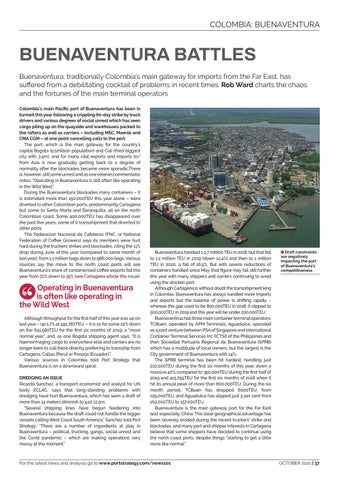COLOMBIA: BUENAVENTURA
BUENAVENTURA BATTLES Buenaventura, traditionally Colombia’s main gateway for imports from the Far East, has suffered from a debilitating cocktail of problems in recent times. Rob Ward charts the chaos and the fortunes of the main terminal operators Colombia’s main Pacific port of Buenaventura has been in turmoil this year following a crippling 60-day strike by truck drivers and various degrees of social unrest which has seen cargo piling up on the quayside and warehouses packed to the rafters as well as carriers – including MSC, Maersk and CMA CGM – at one point cancelling calls to the port. The port, which is the main gateway for the country’s capital Bogota (9.5million population) and Cali (third biggest city with 3.4m), and for many vital exports and imports to/ from Asia is now gradually getting back to a degree of normality after the blockades became more sporadic.There is, however, still some unrest and as one veteran commentator notes: “Operating in Buenaventura is still often like operating in the Wild West”. During the Buenaventura blockades many containers – it is estimated more than 150,000TEU this year alone – were diverted to other Colombian ports, predominantly Cartagena but some to Santa Marta and Baranquilla, all on the north Colombian coast. Some 400,000TEU has disappeared over the past five years, some of it transshipment that diverted to other ports. The Federacion Nacional de Cafeteros (FNC, or National Federation of Coffee Growers) says its members were hurt hard during the truckers strikes and blockades, citing the 11% drop during June of this year (compared to same month of last year), from 1.1 million bags down to 986,000 bags. Various sources say the move to the north coast ports will see Buenaventura’s share of containerised coffee exports fall this year from 72% down to 35% (see Cartagena article this issue).
‘‘
Operating in Buenaventura is often like operating in the Wild West Although throughput for the first half of this year was up on last year – up 1.7% at 491,787TEU – it is so far some 22% down on the 641,580TEU for the first six months of 2019, a “more normal year”, and, as one Bogota shipping agent says, “it is haemorrhaging cargo to everywhere else and carriers are no longer keen to call there directly preferring to transship from Cartagena, Callao [Peru] or Posorja [Ecuador].” Various sources in Colombia told Port Strategy that Buenaventura is on a downward spiral. DREDGING AN ISSUE Ricardo Sanchez, a transport economist and analyst for UN body ECLAC, says that long-standing problems with dredging have hurt Buenaventura, which has seen a draft of more than 14 meters diminish to just 12.5m. “Several shipping lines have begun feedering into Buenaventura because the draft could not handle the bigger vessels calling West Coast South America,” Sanchez told Port Strategy. “There are a number of ingredients at play in Buenaventura – political, trucking, gangs, social unrest and the Covid pandemic – which are making operations very messy at the moment.”
Buenaventura handled 1.3 7 million TEU in 2018, but that fell to 1.2 million TEU in 2019 (down 12.4%) and then to 1 million TEU in 2020, a fall of 16.5%. But with severe reductions of containers handled since May, that figure may fall still further this year with many shippers and carriers continuing to avoid using the stricken port. Although Cartagena is without doubt the transshipment king in Colombia, Buenaventura has always handled more imports and exports but the balance of power is shifting rapidly – whereas the gap used to be 800,000TEU in 2018, it slipped to 500,000TEU in 2019 and this year will be under 200,000TEU. Buenaventrua has three main container terminal operators: TCBuen, operated by APM Terminals, Aguadulce, operated as a joint venture between PSA of Singapore and International Container Terminal Services Inc (ICTSI) of the Philippines and then Sociedad Portuaria Regional de Buenaventura (SPRB) which has a multitude of local owners, but the largest is the City government of Buenaventura with 14%. The SPRB terminal has been hit hardest, handling just 210,000TEU during the first six months of this year, down a massive 40% compared to 350,000TEU during the first half of 2019 and 415,755TEU for the first six months of 2018 when it hit its annual peak of more than 800,000TEU. During the six month period, TCBuen has dropped 6000TEU, from 129,000TEU, and Aguadulce has slipped just 3 per cent from 162,000TEU to 157,000TEU. Buenaventura is the main gateway port for the Far East and, especially, China. This clear geographical advantage has been severely eroded during the recent truckers’ strike and blockades, and many port and shipper interests in Cartagena believe that some shippers have decided to continue using the north coast ports, despite things “starting to get a little more like normal”.
For the latest news and analysis go to www.portstrategy.com/news101
8 Draft constraints are negatively impacting the port of Buenaventura’s competitiveness
OCTOBER 2021 | 37











